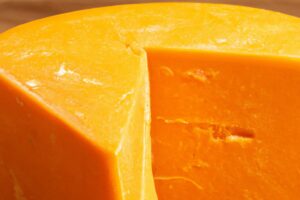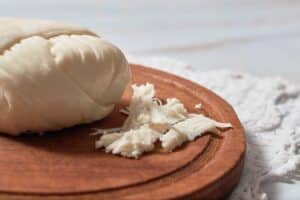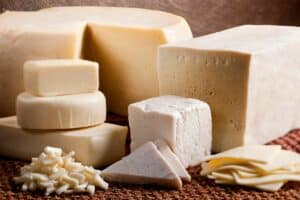Manchego cheese is an excellent table cheese, pairing beautifully with olives and bread. It also holds up well for grilling and recipes requiring melted cheese.
Because of its versatility, it’s understandable if manchego is your cheese of choice. However, if your supermarket sold out of it, we’ll show you some great manchego cheese substitutes.
What is Manchego Cheese?
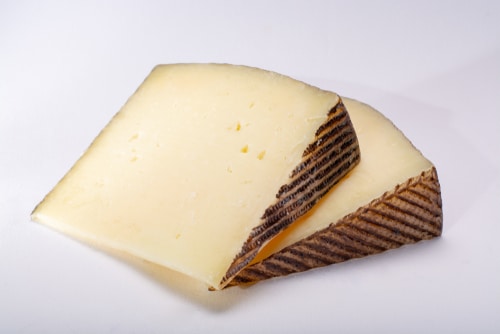
Originating from La Mancha, Spain, Manchego cheese comes from the Manchega sheep. Depending on the variety you buy, the cheese takes two months to two years to age.
Manchego cheese is compact and semi-hard to the touch, so people who try it are often pleasantly surprised by its buttery texture. The cheese has a white to yellowish color, and its beige rind is inedible.
After eating manchego cheese, you’ll recognize a sheep’s milk flavor. It has a small piquancy, although it isn’t an overpowering type of cheese. When you’re seeking a manchego cheese substitute, the alternative cheese you use will depend on the kind of queso manchego you typically consume, for it comes in the following varieties:
- Semicurado- Aged for three weeks to four months. Has a milder flavor.
- Curado- Aged up to six months. Has a caramel and nutty flavor.
- Viejo- Aged for up to two years. Has a sharp flavor.
5 Recommended Manchego Cheese Substitute
1. Mozzarella:
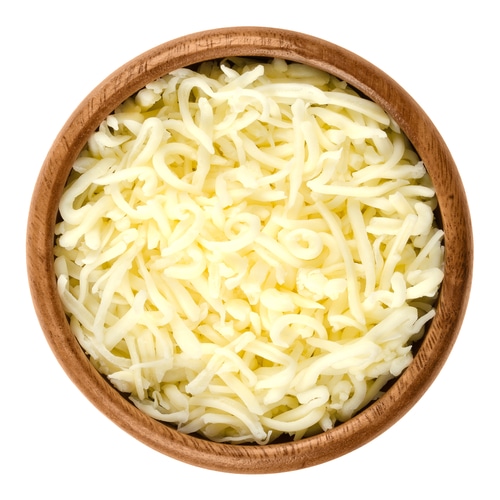
Originating just a few countries over from Spain, this cheese is from Italy and is an excellent option to use in place of manchego.
Perhaps unsurprisingly, since it has its origins in Italy, people make this cheese by kneading it as if it were dough. It has a wetter consistency than manchego cheese and a brighter white color. Traditionally, homemade mozzarella comes in a braided or knotted shape and can weigh three kilograms each.
Compared to manchego cheese, mozzarella has a slightly milder flavor. Cheese enthusiasts will recognize the difference, for it has a cow’s milk aftertaste, whereas manchego cheese has a sheep’s milk aftertaste.
Both cheeses also differ in their presentation. Grocery stores typically sell manchego cheese in either a round block or smaller slices cut from a cheese block. On the other hand, mozzarella often comes in round balls or shredded form. In that case, it may be easier for you to measure out for your recipe compared to manchego cheese.
Mozzarella makes an ideal substitute for manchego cheese if you’re making a recipe that involves melting the cheese. When heated, it takes on a gooey, runny texture like it does manchego cheese. Because this cheese has such a mild flavor, you can use the same amount in your recipe as you would with manchego cheese.
For more information on this cheese, read our article on mozzarella substitute.
English Cheddar
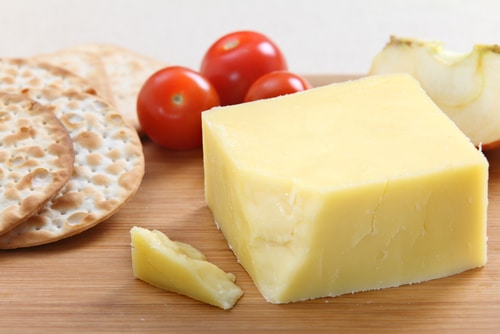
One of the best cheeses for matching manchego’s richness and melting quality is English cheddar cheese. With its roots in Cheddar, England, cheddar cheese soon became an American favorite when settlers brought it to the New World. Today, the northeast continues to have large cow farms and cheddar factories.
Manchego cheese naturally retains a white to yellowish color. On the other hand, you can purchase cheddar cheese in a white or deep yellow color. We recommend purchasing the white variety for your manchego cheese substitute, as this is cheddar’s natural hue and will most closely resemble manchego.
However, if you want to stray from the pack and add some color to your food, go ahead and choose a high-quality yellow cheddar cheese. The more expensive yellow cheddar cheese varieties use annatto as coloring, which is a type of bean.
There’s a reason that cheddar cheese factories started turning their cheese yellow—cows that go out to pasture produce cheese with a slight yellow hue compared to those who eat grain. Therefore, to prevent consumers from seeing the difference in cheddar cheese colors as seasons change, it became customary for factories to turn all their cheese a deep yellow color.
Although manchego and cheddar cheese are similar in texture when you melt them, cheddar has a more robust flavor than manchego. Therefore, you may want to reduce the amount of cheddar cheese you use when substituting it for manchego in your recipe.
Related Article: Freezing American Cheese: Everything You Need To Know
Monterey Jack
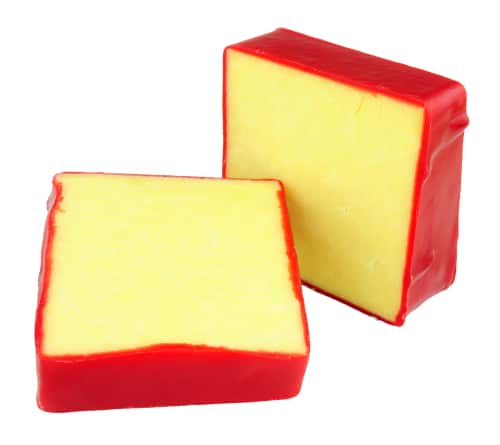
You might be scratching your head at how Monterey Jack cheese is similar to manchego, for Monterey Jack commonly comes in intense dry and pepper flavors. However, traditional Monterey Jack cheese has a creamy and mild flavor similar to manchego cheese.
Like manchego, Monterey Jack cheese is semi-hard and commonly comes in a block form, although it usually doesn’t have the rind attached. The cow-based milk has a mildly sweet flavor in its plain state, which resembles the manchego curado variety.
Monterey Jack cheese has its origins in the United States. Since David Jacks began selling the cheese in the 18th-century, manufacturers now commonly combine Monterey Jack with Colby and cheddar cheeses. When searching for a manchego cheese substitute at the supermarket, it’s important to purchase the softer variety. If you’d like to avoid squeezing all the bags in the cheese aisle, simply look for a label to see how long it underwent aging.
Thankfully, it’s easy to determine how soft Monterey Jack cheese is by looking at the amount of time it aged; if it has one month of aging, it’ll be soft. Monterey Jack cheese that spent anywhere from one to six months aging will be an increasingly firmer cheese with the more time it has to age.
Using Monterey Jack cheese as a substitute for manchego cheese is an excellent option if you plan to melt cheese for burritos or hamburgers, make a grilled cheese sandwich, or a hot pasta dish.
Asiago Cheese
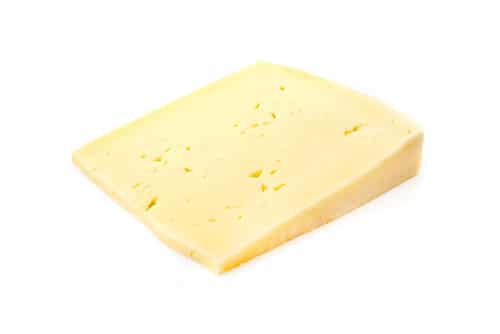
We’ve talked a lot about excellent manchego cheese alternatives when it comes to recipes calling for melted cheese, but you might wonder—what about substitutes for using it as a solid? Asiago cheese is a great choice if you want to use solid or grated cheese in a recipe that calls for manchego cheese.
Asiago cheese originates from cow milk in the Italian Asiago High Plateau. It’s a great addition to top off salads and soup in its grated state. People also enjoy slicing it to serve on paninis and sandwiches.
Like Monterey Jack cheese, the length of time that asiago cheese ages is critical to how conducive it is for use as a manchego cheese substitute. The best cheese to use is Asiago Pressato. As a fresh cheese, the Pressato variety is moist and has a smooth consistency, mimicking the buttery texture of manchego cheese. Asiago Pressato undergoes aging for only a few months.
If you end up purchasing asiago cheese outside of the Pressato type, prepare yourself for a drier and more crumbly cheese that doesn’t resemble manchego. Keep your eyes peeled for an Asiago D’Allevo label—you want to avoid that, as it has a pungent smell and taste. That said, even Asiago Pressato has a slightly stronger scent than manchego cheese.
Another fantastic quality that Asiago Pressato shares with manchego cheese is a slightly nutty flavor and a soft yellowish-white color. As asiago cheese ages, it becomes more yellow and takes on a grainer texture.
Can’t find asiago cheese but want something similar? See popular cheese similar to asiago.
Zamorano
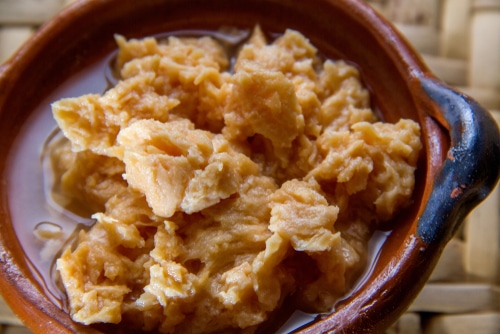
Zamorano cheese isn’t typically a household name, but it shares several key features that make it an excellent substitute for manchego cheese. Most notably, Zamorano is a Spanish cheese and comes from sheep’s milk. Like manchego cheese that originates from the Manchega sheep breed, Zamorano cheese must come from a specific sheep variety. Or, in this case, two breeds—Castilian or Churra sheep.
When you’re at the supermarket looking for Zamorano, it’s easy to mistake its cylindrical shape for a block of manchego. Furthermore, Zamorano cheese has a zigzag pattern on its rind, just like manchego. Its color is also similar, with a white or pale yellow hue. However, once you cut into a block of Zamorano cheese, you’ll notice how it’s different since it’ll feel both firmer and more crumbly beneath your knife.
A buttery flavor makes Zamorano stand out as an excellent manchego cheese substitute. In fact, like manchego, it even has hints of a nut taste. These flavor combinations result from the higher-than-average fat content of this cheese, although a high-fat content is typical of most cheeses.
Although Zamorano and manchego cheese have their similarities, they differ in their texture. Whereas manchego has a smooth surface, Zamorano has a crumbly texture. Therefore, Zamorano isn’t a good manchego alternative if you plan on slicing it to use for sandwiches.
Like manchego cheese, Zamorano is a fantastic cheese to eat on its own, paired with a good wine, bread, and dried tomatoes in olive oil.
Conclusion
With so many options for manchego cheese substitutes, there’s no need to worry if you don’t see manchego cheese in your local grocery store. Once you have access to manchego cheese again, you may find that you continue including these cheese alternatives on your weekly grocery list!
More Cheese Substitute:


